|
Chronology Of Recent Discovery At Abusir
|
A New And Significant Discovery
The Intact Tomb of Iuf-aa
by Dr. Zahi Hawass
|
Chronology Of Recent Discovery At Abusir
|
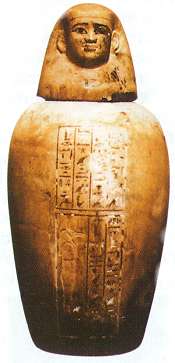 The Supreme Council of Antiquities and the
Czech Expedition announced the
discovery of the first intact tomb since Tutankhamen's tomb. The tomb of Iuf-aa Director
of the Palace, has not been entered since the burial rites were usually performed
twenty-five centuries ago. The value of this tomb is further enhanced by the fact
that it is the seventy-fifth anniversary since an intact burial of this type has been
discovered. However the significant difference between the two intact tombs is the
status of the two persons concerned. The tomb of Tutankhamen was full of gold and around
5000 artifacts, on the other hand as Iuf-aa was a palace controller, we did not expect to
find gold, nevertheless, important and exciting artifacts were discovered which will
help to provide answers to questions regarding Ancient Egyptian history and burial rites.
The Supreme Council of Antiquities and the
Czech Expedition announced the
discovery of the first intact tomb since Tutankhamen's tomb. The tomb of Iuf-aa Director
of the Palace, has not been entered since the burial rites were usually performed
twenty-five centuries ago. The value of this tomb is further enhanced by the fact
that it is the seventy-fifth anniversary since an intact burial of this type has been
discovered. However the significant difference between the two intact tombs is the
status of the two persons concerned. The tomb of Tutankhamen was full of gold and around
5000 artifacts, on the other hand as Iuf-aa was a palace controller, we did not expect to
find gold, nevertheless, important and exciting artifacts were discovered which will
help to provide answers to questions regarding Ancient Egyptian history and burial rites.
It is essential to understand the importance of the religious
aspects of death and the afterlife to the Ancient Egyptians, to be able to understand
fully the significance of the artifacts found in the burial chamber of this intact
tomb. To
the early Egyptians the natural occurrence of nature, the daily rising and setting of the
sun, the annual fertilizing flood of the Nile and the growth of crops, were seen as cycles
of life, death and rebirth. They gave assurance that mankind was also part of these cycles
and could expect life after death. This was reinforced by the mythology of Osiris, the God
who died and was brought to life again as the ruler of the underworld.
At death, the Egyptians believed that a persons being was fragmented into several
elements, which included the Ka, the Ba, and the Akh. The Ka was the individual life force
and protective genius, present in life, it had the same needs after death - food,
drink and shelter. The tomb was built for the Ka, as a dwelling place where offerings were
presented. The Ba was a more mobile spirit entity and was depicted as a human headed bird.
It could travel between the tomb, the celestial regions, and the underworld. It was
the Ba that had to find its way to the judgement hall of Osiris, where it had to answer to
the forty-two assessor Gods and convince each of them in turn that he had not
sinned:
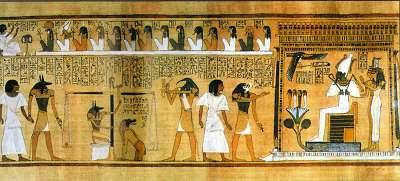
Vignette from Hunefer's Book of the Dead
Those who did not pass the judgement were denied entry into the realms of Osiris and died forever. Those who do pass the test were given eternal life in the afterworld. The focus of many of the funerary practices was the union of the Ka and the Ba after death. When this was achieved, the deceased became an Akh, a transfigured spirit whose place in the afterlife was assured.
You have gone away to live.
You have not gone away to die.
You have gone away to become ankh among the ankhs.
In order to accomplish this reunion, the Ka needed a home base which is the body, and
was undoubtedly the reason why mummification played such an important role in Egyptian
funerary practices. To safeguard the body, elaborate tomb structures were developed. These
varied over time, but always included the burial chamber, which was below ground and
sealed. Above or near the burial chamber was usually - but not always the offering place,
this could be a niche or a false door set in a wall, and an offering table. In wealthier
tombs, the false door was housed in a decorated multi-roomed chapel that was accessible to
visitors.
Finding an intact tomb enables us to know and confirm the religious beliefs of the
specific dynasties. This is why the intact tomb of Iuf-aa was a remarkable discovery.
The tomb of Iuf-aa consisted of a shaft about 28m deep. Inside this shaft was the
intact tomb, an enormous white limestone sarcophagus weighing about 50 tons, intact
because the plaster seal between the lid and the sarcophagus was unbroken. Around the base
of this and in the narrow aperture between the sarcophagus and the tomb, was the complete
burial equipment including; a full set of 408 faience ushabitis, four canopic vessels with
human-headed lids, wooden furniture, stone vessels of various sizes and a considerable
quantity of pottery, much of it consisting of foreign imports acquired during the reign of
the King.
The walls of the tomb and the outer walls of the sarcophagus itself are of great interest,
they are covered with hieroglyphs, many being of exquisite beauty. These hieroglyphs
repeat the spells and invocation prayers of the ancient pyramid texts that in the Old
Kingdom had been reserved only for the pyramids of the Kings. There are also extracts from
later religious texts, including the Book of the Dead that started in the New Kingdom
(1550 B.C.). These hieroglyphic inscriptions helped the deceased to ascend to the sky and
explain the relation of the deceased and the Gods. Major discoveries take time to reveal,
as was the case in the discovery of King Tutankhamen's tomb. The steps of the Kings tomb
were discovered on the 4th November 1922. On the 26th of November 1922, Carter and Lord
Carnavon opened a hole to see inside and the official opening took place on the 9th of
February 1923 and it took Carter a long time to record and restore, all of the artifacts
inside the tomb. The intact tomb of Iuf-aa was found near the tomb of Udjahorresnet and
was one of four shafts that were found through a geographical survey of the site.
Excavation Of The Shaft Tomb
| Excavation of the shaft tomb situated to the south-east from the shaft tomb of Udjahorresnet in the southwestern sector of the Abusir necropolis, began in January 1995. The mouth of a small shaft, measuring about 1.7 x 1.4 in and the upper part lined by mud brick, was discovered under the limestone plastering lying in front of the larger niche in the western outer face of the mud brick enclosure wall surrounding the main shaft of the tomb. During January 1996, the expedition started to remove the sand from the shaft 6m deep. The expedition was headed by Dr. Ladislav Bares, Deputy Director of the Czech Expedition, accompanied by three excellent "Reis" (overseer) Muhammed Talah elKereti, Abd el-Mitaal el-Kereti, and Ahmed el-Kereti, the sons of el-Kereti family, a great overseer who maintain the same techniques used by the Ancient Egyptians and using their skills to move large stones with the same ease of their forefathers. |
|
The expedition was also joined by Mr. Attalla el-Kholy, an excellent archaeologist and
Inspector of Antiquities of the Supreme Council of Antiquities. Their achievements proved
that they were the right team for excavating this site. Removing the sand from the shaft
was very exciting, they tied baskets to ropes and sent them 19m down the shaft to the
workmen below. They filled the baskets with sand and hoisted them back to the surface. To
speed up the process they used a new method, a tool which in Arabic is called el-Tanbora.
During the clearing of the main shaft from sand and debris, at about 10m deep a few white
limestone fragments with the remains of hieroglyphic inscriptions in incised relief were
discovered, including several pieces of pottery dating back from the late to early
Byzantine periods. Among them numerous fragments of imported Greek and Aegean Pieces of
the late 6th century B.C.
At a depth of approximately 21m, the ceiling of the burial chamber was unearthed. Oriented
east-west and consisting of a vault built of roughly cut limestone blocks. To the west of
the burial chamber proper and adjacent to the western wall of the main shaft, an irregular
mud brick wall was discovered, which measured 2m high along its entire length. In the
centre of this wall, the eastern entrance to the corridor connecting the main shaft with
the small western shaft was opened, protected from above by another mud brick vault. In
the middle of the western wall of the main shaft of the complex, a niche about 4m high, 2m
wide and 1m deep was cut, leading to a chimney in the ceiling of the corridor below it.
The mud brick structure, adjacent to the western wall of the main shaft was in no way
connected with the western wall of the burial chamber proper, the free space between both
structures being about 1.7m wide.
At about the level of the lateral walls of the burial chamber, the bottom of the main
shaft, measuring about 11m x 11m, is crossed by several thin mud brick walls, built here
probably with the aim to strengthen the stability of the sand surrounding the burial
chamber. These mud brick walls have been traced to the depth of about 25m.
When the excavators removed the sand entrance, which was sealed with limestone blocks,
they discovered an intact tomb. It was the 5th of March 1996 and Verner, head of the Czech
Expedition commented "I was not as happy as the workmen were, they had, tears in
their eyes, they were cheering 'Allah Akbar, Allah Akbar (God is Great, God is
Great)". The team had anticipated that the burial chamber was intact with all of the
original burial equipment. They had to inform us of the discovery, I sent a message to the
Director of Saqqara to attend the opening of the tomb. I did not attend myself because I
was convinced that it had been robbed like all other shaft tombs. Mohammed Hagras, the
Director of Saqqara, went to the site and attended the opening of the burial chamber, then
telephoned me to report what he had seen. I rushed to the site. The Reis of the workmen
attached the harness around my waist connected to rope and lowered me down very slowly for
more than 21m, until I reached the ground. The burial chamber proper, about 4.9m long and
3.3m wide, was found half filled with a thick layer of sand covered from above the mud
brick and by rough limestone blocks. On top of this layer, pieces of the original
burial equipment were found. To the north of the entrance, were the remains of a damaged
wooden chest, adorned with a concave
cornice.
This originally contained more than 30 small faience and pottery
vases for sacred oils - partly inscribed with the original
contents - as well as a medium sized bronze vessel, two bronze models of offering tables -
with four vessels on top of each - four The concrete dome at the top of
the shaft miniature alabaster tablets, two small schist amulets, a double ostrich feather
and an upper Egyptian Crown, two miniature models of offerings made of wood and ivory, a
silt magic brick with faint remains of a heretic inscription that would protect the
deceased from the devil, remains of a papyrus roll - almost destroyed by humidity
and unidentified copper and iron fragments. Along both the northern and southern sides
of-the chamber, one flat open box was discovered full of blue-glazed faience shabtis (203
in the north and 205 in the south, i.e. 408 altogether). The shabtis were statuettes
decorated with hieroglyphics and put in the tombs to answer the questions that the Gods
ask the deceased in the afterlife. The name Shabtis in hieroglyphic means the 'answerer',
also the shabtis are destined to perform- tasks for the deceased, such as agricultural
duties. The number used to be the number of the days of the year, with each Shabtis
assigned to working one of those days, but later this number was increased. The style of
the Shabtis of this period can easily be recognised, they are made of faience, with a base
and a pillar supporting their back. Also found in the area between the sarcophagus and
the tomb wall, a chest containing two canopic jars. All these boxes and chests -made of
wood and bearing traces of the original decoration and texts on a thick layer of black
varnish- have been found almost destroyed by natural humidity. All four canopic jars bore
conical lids in the shape of human heads, inscriptions and images of the four sons -of
Horus. They were called canopic, because they were first found in a village near
Alexandria called Canop.
Adjacent to the eastern wall of the burial chamber, two stone vessels
were discovered, the first being small and made of alabaster and not inscribed, the second
was large and made of pink limestone, bearing an inscribed Anubis formula as: A gift which
the King gives and a gift (which) Anubis in front of the divine booth. Remains of other
papyrus rolls were discovered in a
partially destroyed wooden box x in the northwestern corner of the chamber. In the sand
layer to the west of the sarcophagus, three more magical bricks of the same type described
earlier, and other amulets were found.

The concrete dome at the top of the shaft
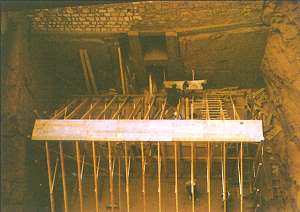
Stone vessels osed for ointment
All four inner faces of the chamber walls are covered with inscriptions
and images in low relief, except on the roughly worked vaulted ceiling and the lower half
of the western wall, where the inscriptions are only partly prescribed in red, while the
other portions remain empty. On the eastern wall, the inscriptions cover the full height
(about 3.3m), on the lateral northern and southern wall, the space covered by texts and
representations is about 1.8m high. The burial chamber is dominated by a huge white
rectangular limestone sarcophagus, weighing about 50 tons, and a flat lid with lowered
edges. The chest of the sarcophagus- standing on a platform, which is about 35cm in
height, about 3.8m long, 3.3m wide and 1.41n high. The lid is about 1m thick, joined with
the chest by means of a thick layer of coarse lime plaster. All four outer faces of the
chest of the sarcophagus are completely covered by columns of hieroglyphic inscriptions,
roughly cut in low relief. The inscriptions on the anthropoid sarcophagus are spells to
safeguard the deceased and the seven snakes responsible to protect the deceased in the
after-life. The undecorated lid with two irregular handles projecting to the east and west
respectively.
According to the inscriptions, the tomb was built for a person named Iuf-aa born to a lady
called Ankht-es but the name of the father is not found, Iuf-aa held the titles hrp-hwwt
Director of the Palaces and title of hry-hbt- Lector Priest.
Due to of the very high level of natural humidity all the pieces of the original burial equipment made of organic matter -papyrus and wood- were found badly destroyed despite an immediate treatment by a Farouk Hosni, minister of Culture, lady Ambassador of the Czech Republic, specialist in the Dr. Gaballa, General Secretary of the Supreme Council of Antiquities
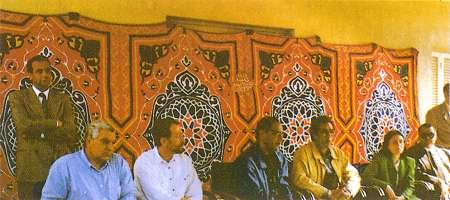
Farouk Hosni, Minister of Culture, Lady Ambassador of the Czech
Republic, Dr. Gaballa, Secretary General of the Supreme Council of Antiquities
Conservation Department at the Saqqara Inspectorate, they were partly
rescued from immediate decomposition. High levels of natural humidity, the usage of low
quality limestone blocks also led to minor damage to the inscriptions on the walls of the
chamber, however this damage had been repaired already by whitish plaster.
All original burial equipment found inside the burial chamber of Iuf-aa and all other
important findings, have been transferred to the storeroom and when necessary, treated by
experts in restoration. However due to technical reasons, the opening of the sarcophagus
was - postponed to Autumn 1996, the beginning of the next archaeological season.
At the end of this season, the entrance to the burial chamber was officially closed by two
locks and sealed by a committee of Inspectors of Antiquities at Saqqara. In a similar
way,., the corridors leading to the burial chamber from smaller accessible shafts were
closed and sealed. Following the closure of the smaller shafts they were filled with clean
sand and their mouths were covered with concrete slabs.
It is very interesting to note that all of the four canopic jars found in the burial
chamber were filled to the top with a liquid. One in particular contained a material that
had a strong odour, and may come from remains of the mummification process. I believe it
is the hot resin that seals each layer of the bandages wrapped around the mummy.
Another important point to mention is that we were unable to locate the name of the father
of Iuf-aa it was not written anywhere inside the tomb, he could have been the friend of
the betrayer, Udjhorresnet, and therefore would explain his burial in this isolated area
of Abusir.
However, this initial opening of the intact tomb was not announced to the public due to
fear of tomb robbers known to this area, although the area was well guarded by police to
safeguard the safety of the contents of the tomb.
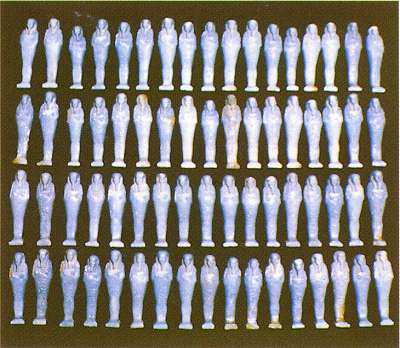
Shabtis were found inside the tomb
The Impact Of The 1992 Earthquake
In October 1992, an earthquake occurred in Egypt, the epicentre was in Dahshur, South of
Abusir, this was followed by a series of other earthquakes. At the beginning of September
1996, during the absence of the Czech archaeological expedition from Abusir, a part of the
north wall of the main shaft of the tomb of Iuf-aa collapsed due to these subsequent
earthquakes. The collapsed tafla and mud brick, broke through the strong roof of wooden
beams and planks, built at the end of the previous season to protect the burial chamber of
Iuf-aa at the bottom of the main shaft. At this time I was lecturing at UCLA in the United
States, so Verner informed me of the collapse of the roof and as a quick solution, we
decided to fill a major portion of the shaft with sand to increase the stability of the
whole monument and to avoid further damage. When I returned from the States, we invited
Dr. Hassan Iman a professor in the faculty of Engineering - Cairo
University and Engineer Michael Balik, the architect of the Czech Archaeological
Expedition, to give their advice.
Carefully, the main shaft was cleaned again. Loose pieces of tafla were removed and
fissures in the side walls of the main shaft were filled with limestone blocks and lime
mortar. The walls and floor of the burial chamber to the south were also strengthened.
Engineer Michael Balik prepared a plan to consolidate the shaft complex, which would
protect the burial chamber of Iuf-aa and prevent any future earthquake damage. We
discussed the plan and found it to be the most effective way of protecting the tomb. The
plan required a large reinforced concrete dome, constructed at the bottom of the main
shaft. The foundation of the dome is deeper than the burial chamber and is embedded in a
thick layer of sand mixed with limestone chips, filling the bottom of the main shaft. The
side walls of the dome are 10m high and about 1.5m thick. The saddle roof of the dome is
about 0.5m thick and is intended to support the weight of the filling of the remaining
area in the upper part of the shaft. During all works connected with the building of the
concrete dome, the burial chamber of Iuf-aa remained covered with a 2m thick layer of sand
in addition to many layers of plastic. All of this effort was intended to stabilise the
shaft and to make sure that during this current season of 1998, Iuf-aa's tomb could be
opened under a safe, reinforced concrete gable.
It is not easy to find the words to describe the courage of all the people involved in
this project in particular the workmen. Building the gabled coffer in the desert, at the
bottom of the huge shaft was not an easy task. Every drop of water had to be brought on
the backs of donkeys, irrespective of 30 tons of steel rods -some of them almost 3cm thick
in diametercement, wooden beams and planks etc. In total about 400 cubic meters of
concrete was used.
We must give credit to the generosity of the Czech Expedition, who totally funded and
executed the plan.
After the construction of the dome, an expert committee declared that the burial chamber
of Iuf-aa had survived the incident of last September without any major damage. The sealed
sarcophagus of Iuf-aa remained absolutely untouched, along with the inner side walls of
the burial chamber densely covered with inscriptions and scenes in low relief. Only a
small part at the top of the eastern wall of the chamber chipped off and was fully
restored by an expert from the Supreme Council of Antiquities at Saqqara.
However, major portions of the undecorated vaulted ceiling of the burial chamber did not
survive the stroke of the debris from the north wall of the main shaft. Theoretically, it
would have been easier to restore the original vaulted ceiling of the chamber. However,
after consultation with the Supreme Council of Antiquities, it was decided that the blocks
of the ceiling would be dismantled, since the future lifting of the lid of the sarcophagus
would mean the ceiling would have to be removed. The blocks of the ceiling were removed,
numbered, and stored in another area of the burial chamber.
The Opening Of The Sarcophagus
Opening an intact sarcophagus is a significant event and I recall the comment of Verner,
the head of. the Czech Expedition "It is a once in a lifetime event for an
archaeologist to find an intact tomb. I am overwhelmed and could not sleep the night
before the opening of the sarcophagus".
In February 1998, preparations were made for the opening of the sarcophagus of Iuf-aa all
necessary precautions were taken to avoid any miscalculations or accidents.
On his journey back to Cairo Verner brought devices to be used in the lifting of the lid
along with other equipment. Serious considerations were taken in preparation to lift the
20-ton monolithic lid of the sarcophagus to create access in the burial chamber. The
expedition built a new wooden staircase to be used by celebrities who will attend the tomb
during the opening. But, before the staircase could be built they had to send down the
large wooden sledge that they would use to open the 20 ton lid. The lengths of the sledges
were about 7.5m and each weighed 600 kilograms.
After the preparations, Verner informed Dr. Gaballa Ali Gaballa, General Secretary of the
Supreme Council of Antiquities and myself that the opening would take place on the 17th of
February 1998.
Dr Gaballa invited Mr Farouk Hosni, the Minister of Culture to attend the press conference
and the opening. We suggested to Verner that the opening of the sarcophagus should take
place before the press conference, as a safety precaution should anything occur.
|
I had to be in Abusir everyday to attend this historical event. It was
again an ingenious plan of Engineer Balik who designed the raising of the huge lid of the
limestone sarcophagus. The lid was raised by a combination of hydraulic and also
mechanical jacks to the height of about one-meter. With the assistance of the workmen
within ten minutes, four huge (31 x 31 cm) 7.5m long wooden beams were inserted under the
raised lid. Two mechanical jacks. were then used to push the lid aside to the new
resting-place. Beneath the limestone lid was something beyond our imagination, the removal of the lid revealed a beautiful anthropoid sarcophagus of dark greenishblack schist. This anthropoid sarcophagus was firmly embedded in a mould within the limestone chest. The side walls of which were finely carved. There was fine detail of the face and also coloured hieroglyphic inscriptions and scattered vignettes in sunk relief. Scheduling for the opening of the second sarcophagus took place on the 25th of February 1998. The opening of the lid of the anthropoid sarcophagus was attended by Farouk Hosni, Minister of Culture, Dr. Gaballa, International Press, television crews and National Geographic Television team, within the stone sarcophagus lay an anthropoid wooden coffin, covered with a layer of stucco bearing coloured decorations including inscriptions. Under the completely rotten lid, which turned into powder by the mere touch of a finger, appeared the mummy of Iuf-aa We were the first to see him in over 2500 years. |
The mummy was firmly bound with linen wrappings, glued together by dark
resins. Traces of bright gilding remained on the portions of the face that had not been
damaged by the humidity. A broad collar known to the Ancient Egyptians by the name of
Wesekh, went from the neck to the breast. Over the body lay a fragile net shroud of blue
faience beads, among which were a number of cut-out figures of various Gods and Goddesses.
On the chest a winged figure of the Goddess Nut of the Sky, two pairs of the sons of Horus
placed on the thighs and the sister Goddesses Isis and Nephthys kneeling at the ankles.
Moving The Mummy To Giza Lab
On March 1, we moved the mummy by guarded police motorcade to Giza for x-rays by Dr. Euyen
Strouhal, who found that the deceased Iuf-aa died at the age of 54. The mummy was returned
by police motorcade to Abusir following the x-ray.
It is my belief that the sands of Egypt still hide many undiscovered secrets, and will do
so forever.
Reprinted from the January/March 1999 issue of Horus magazine with the permission of Dr. Hawass
Return To The Plateau Homepage